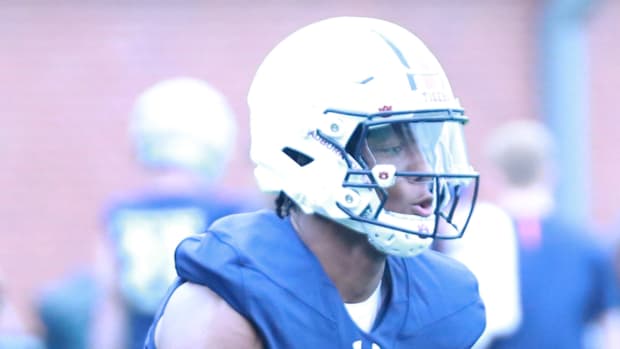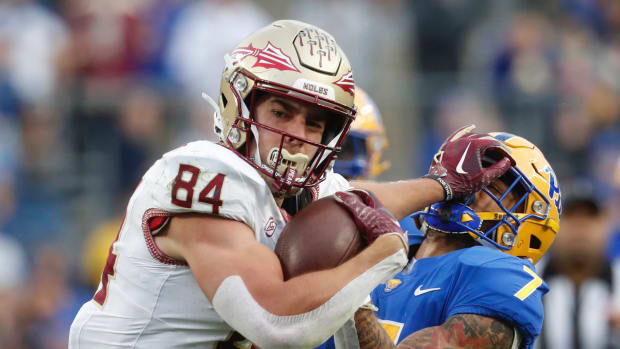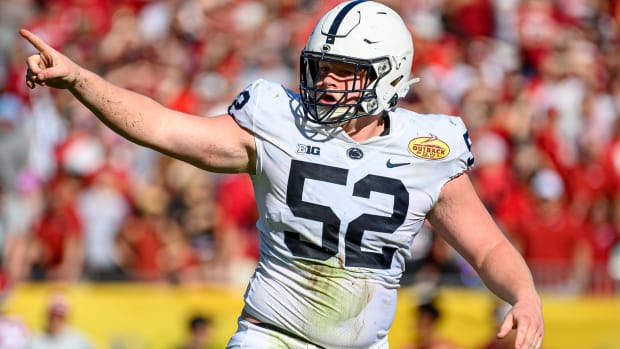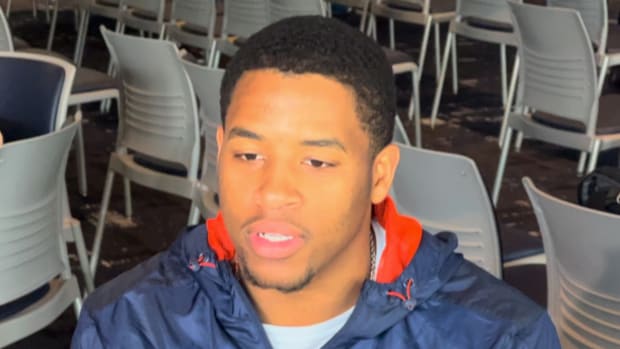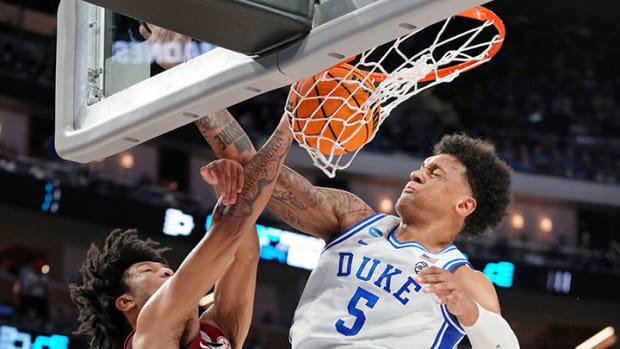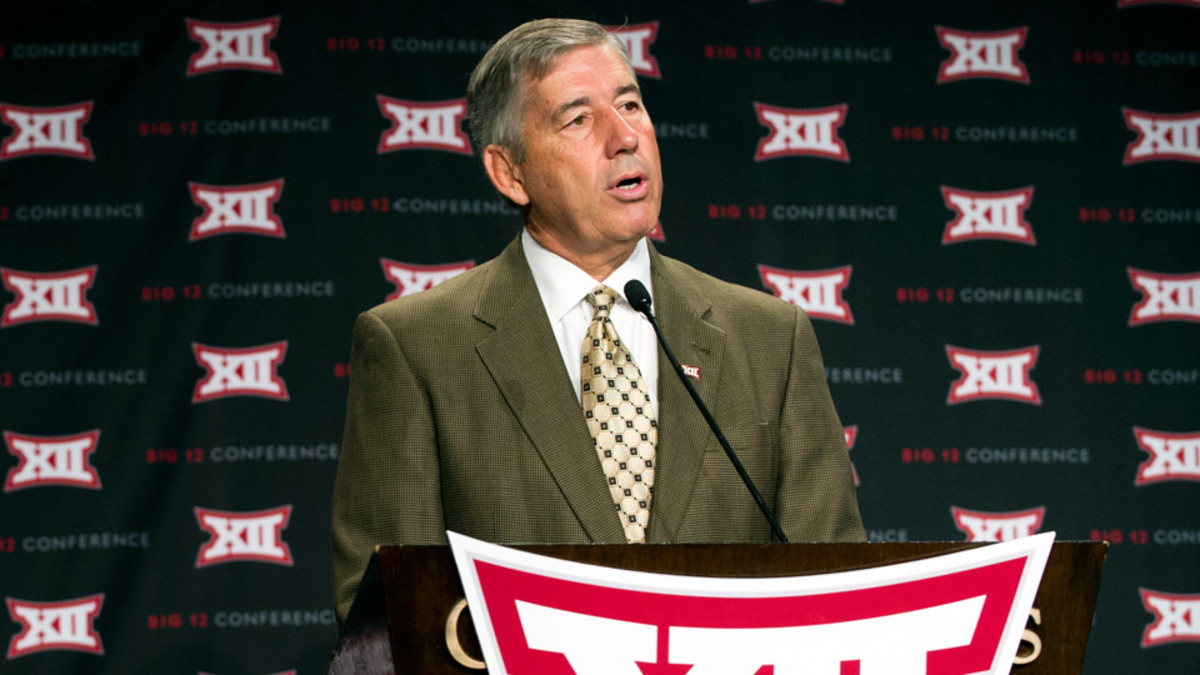
Big 12 executives discuss what should guide college sports change
NEW YORK -- The question that prompted the event was simple enough: What are the biggest issues facing college sports? Over two hours Wednesday evening, a 10-member panel at the Big 12 forum on the state of college athletics addressed a number of high-profile concerns, from the new governance model that will be voted on Thursday to the looming O’Bannon v. NCAA decision to the manner in which schools educate their student-athletes about acting responsibly.
The panel, which featured Big 12 commissioner Bob Bowlsby, Texas men’s athletic director Steve Patterson and West Virginia athletic director Oliver Luck, among others, provided valuable insight. Some offered potential solutions to problems. Others delivered rebuttals. From a micro perspective, the group achieved its goal of furthering a conversation that has seemingly shifted from stagnant to overdrive within the span of a few years.
But from a macro sense, the discussion at the New York Hilton in Midtown Manhattan reinforced another notion: There is currently no guiding principle as to why change should be enacted. With inevitable reform on the horizon, that’s a pretty terrifying thought.
Start with the divide between the haves and the have-nots, perhaps the most common topic of debate heading into Thursday’s vote on the governance model. After all, the Power Five conferences requesting a significant degree of autonomy was the impetus behind this round of proposed changes. They want to provide scholarships beyond room and board, books, tuition and fees. They want to improve living conditions for student-athletes. They want the ability to create their own set of regulations.
They also have drawn the ire of smaller leagues and divisions, which fear the gap between wealthy and less wealthy schools will only continue to expand.
“The rules and the changes that might be made are an attempt to be permissive, but they’re also intended to take into account the fact that those 65 [power-conference] schools are largely the face of what most people know as college athletics,” Bowlsby said. “… I think we got to a place where we just believe that there was a need for us to perhaps be a little less egalitarian, a little less magnanimous of the 350 schools and spend a little time worrying about the most severe issues that are troubling our schools among the 65.”
Bowlsby is correct. The imbalance between the haves and have-nots has always existed, whether in terms of recruiting or facilities or otherwise. That follows the free-market line of economic rationale. But does he hold a similar opinion when it comes to, say, paying athletes from sports such as football and men’s basketball who bring in the overwhelming majority of an athletic department’s revenue?
“I think if we ever go down the path of creating an employee-employer relationship, we will have forever lost our way,” Bowlsby said. “… If you apply any form of the labor theory of value, that is to say the work that goes into something is determinant of the cost, football and basketball players don’t work any harder than any other athletes. They don’t work harder than swimmers. They don’t work harder than field hockey players. They don’t work harder than wrestlers. They just happen to have the blessing of an adoring public.
“If you’re going to compensate for expenses for football and basketball players, it isn’t even arguable that we wouldn’t do it for every other student-athlete on our campus.”
No one is arguing swimmers, field hockey players and wrestlers don’t work hard. They do. But if one athlete’s product is worth millions more dollars than another athlete's, wouldn’t it make sense the former athlete is worth more, too?
Or take the discussion surrounding players' name, image and likeness rights (NIL), the core issue in the landmark antitrust lawsuit heard in a federal courthouse in June. Luck expressed his support of paying players for their NIL rights, for which ex-UCLA basketball standout Ed O'Bannon and his team of plaintiffs sought compensation. “I have a lot of respect for a person’s name, image and likeness,” Luck said. “That is who you are. That is your identity. That’s sort of existential. And, ultimately, I think if we are in fact using the name, image and likeness of a student-athlete -- I don’t think he or she waives that right just because they accept a scholarship -- I think they should be compensated.”
Patterson, however, spoke out against the idea, contending that the name on the front of the jersey enhances the name on the back of the jersey, and that student-athletes are receiving tangible benefits right now. “I don’t think you should create a marketplace for the one half of one percent that might have a certain market value and then distort all the competitive issues around that and all the revenue issues around that,” he told a group of reporters after Wednesday’s event. “I think we have done a poor job of talking about that.”
Finally, look to the NCAA’s enforcement branch, which Bowlsby blasted at Big 12 media days. The commissioner was refreshingly candid when he said, “Cheating pays.” One only need reference the bungling of the Miami case -- an investigation that got vice president of enforcement Julie Roe Lach fired -- for proof.
But many of the changes Bowlsby and his fellow major-conference commissioners desire bring the oft-rumored threat of unintended consequences. So, wouldn’t those also be high-priority issues?
Having this kind of conversation is important. Student-athlete welfare is important. Education is important. And these types of talks indicate real steps toward change.
But before hurtling toward change, shouldn’t we embrace some sort principle behind the progress? Near the beginning of the panel’s discussion, Baylor president and chief executive officer Ken Starr posed a straightforward question, “What is college athletics?” The members’ responses all seemed to differ.
In a way, we’re acting as pseudo-counselors here: Everyone acknowledges there are issues, and everyone is working their damnedest to fix them. Yet the details of each issue produce contradictory messaging, and that breeds confusion.
That makes change certain, but the effects of such change an area of major uncertainty. At the most basic level, we've lost sight of the purpose of college sports. That, possibly more than anything else, is one of the biggest issues facing college athletics in 2014.
